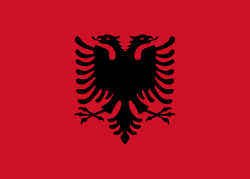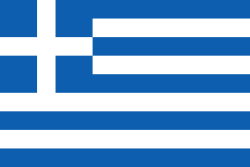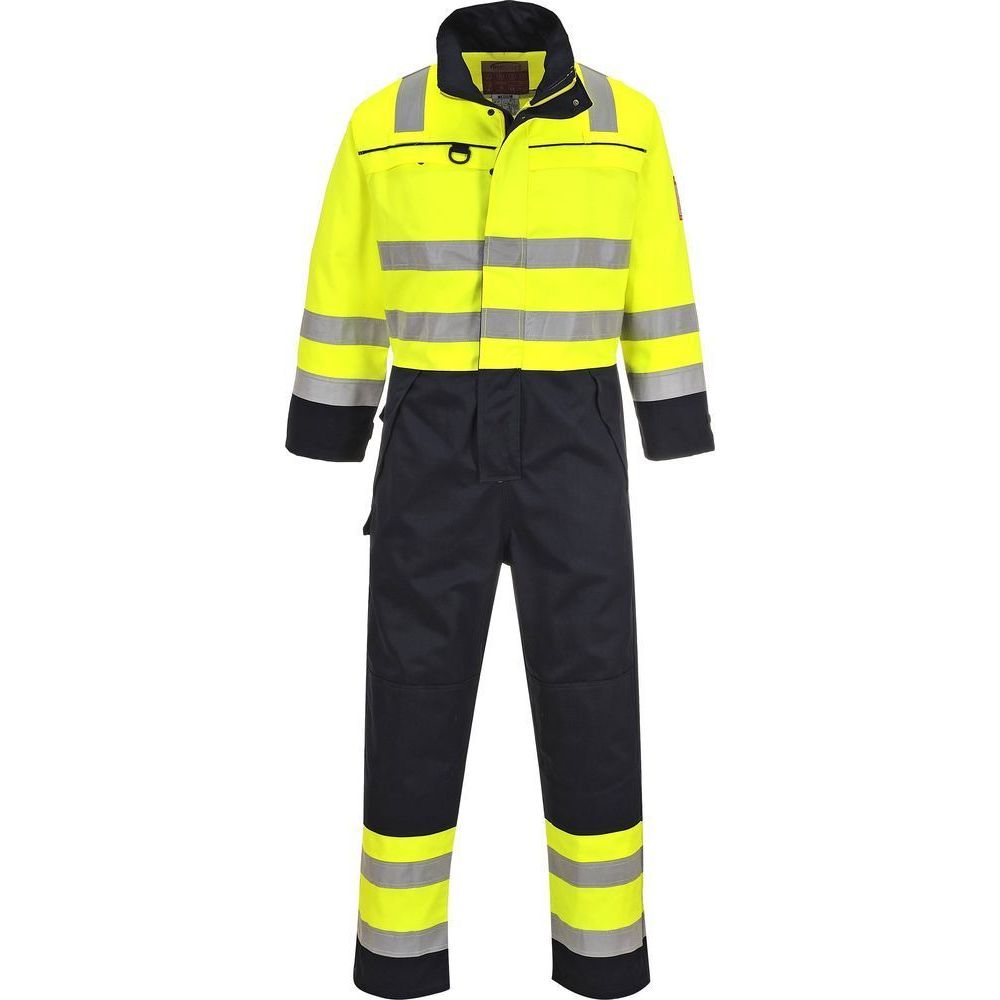FR60 Kominoshe Hi-Vis Multi-Mbrojtje
FR60 është ndërtuar nga pëlhura inovative Bizflame Multi. Kjo veshje e rehatshme ofron mbrojte kundër shumë rreziqeve duke përfshirë ekspozimin ndaj nxehtësisë, zjarrit, kimikateve, harqeve elektrike dhe saldimit. Veçoritë përfshijnë shirita dopjo me ngjitje Hi-Vis në kraharor, krahë, shpatulla dhe këmbë, hapje ballore të fshehtë me zinxhir, dy xhepa kraharori me zinxhir, xhepa anësorë me kapak dhe një xhep vizore. Veshja gjithashtu ka xhepa për mbrojtëset e gjurit të dizenjuara me një sistem inovativ të rregullueshem.
Veçoritë
Mbrojtje nga nxehtesia rezatuese, konvektive, dhe me kontakt
E certifikuar për mbrojtjen nga skorjet e metaleve të shkrira
Xhepa ne kraharor me mbyllje me kopsa
Hapje anesore e lehte dhe e shpejte
Menge të rregullueshme Hook & loop
Ngjyra me kontrast për shtim stilesh
Qepje të trefishte për qëndrueshmëri shtesë
Zinxhire bronxi për durushmerishe të gjate
Xhepa me dy pozicione për mbrojteset e gjurit
Lak për radio
Ka Shirit Flake Durues për Larje Industriale
pëlhurë e klasifikuar me UPF 40+ për të bllokuar 98% rrezeve UV
Zinxhir i Dyanshem për Hapje të Shpejte
9 xhepa për hapsire mbajtese me të madhe
CE-CAT III
Xhep telefoni
Ambalazhimi i produktit është i pershatshem për tu reklamuar ne dyqan
Certifikim CE
Materialet:
Pëlhura Jashtme/Kryesore: Bizflame Multi: 99% Pambuk, 1% Fibër Karboni 345g
STANDARTET
EN ISO 11612 (A1+A2, B1, C1, E3, F1)
EN ISO 11611 Klasi 1 (A1+A2)
EN 1149-5
IEC 61482-2 IEC 61482-1-1 (Elim 13 CAL/CM²)
IEC 61482-2 IEC 61482-1-2 APC 1
EN 13034 Tipi 6
EN ISO 20471 Klasi 3
ASTM F1959/F1959M-12 (ATPV=13.6 Cal/CM² (HAF=82%))

PORTWEST
For over 117 years we’ve possessed an unrelenting ambition to produce the world’s most trusted and requested protective wear. Through the decades, we have continuously proven our dedication to quality, producing world beating safety garments, foot protection, hand protection and PPE, while pushing the boundaries in protection technologies. Technologies that make the workplace a safer place.
EN ISO 20471 Hi-Vis Class 3
EN ISO 20471 is divided into three classes, the requirement for the area consisting of reflectors and fluorescent materials – that determines which class you need to choose. Minimum areas of visible material in m². Class 3: Reflective Tape = 0.20m², Fluorescent material = 0.80m². Class 2: Reflective Tape = 0.13m², Fluorescent material = 0.50m². Class 1: Reflective Tape = 0.10m², Fluorescent material = 0.14m². The highest class is class 3. There are two ways to attain class 3. Either choose an EN ISO 20471 product that is rated class 3 on its own (e.g. a jacket) or choose two products that together are class 3 certified.Details
EN ISO 11612 Heat & Flame
This test uses standard methods and conditions to predict the performance of fabric/garments in the event of contact with heat or flames. Specific testing is listed below: Dimensional change, Limited flame spread (A1+A2), Convective heat (B) - 3 levels, Radiant heat (C) - 4 levels, Molten aluminium splash (D) – 3 levels, Molten iron splash (E) – 3 levels, Contact heat (F) – 3 levels (temperature 250 degrees Celsius)Details
EN ISO 11611 Welding & Allied
Standard specifies two classes with specific performance requirements. Class 1: is protection against less hazardous welding techniques and situations causing lower levels of spatter and radiant heat. Class 2: is protection against more hazardous welding techniques and situations causing higher levels of spatter and radiant heat.Details
IEC 61482-2 Protective Clothing Thermal Arc Hazards
Standard for protective clothing against the thermal effects of an electric arc event. Two different test methods: Open Arc IEC 61482-1-1 and Box test EN 61482-1-2. OPEN ARC - IEC 61842-1-1 (USA). The first result, ELIM - The maximum incident energy (cal/cm²) the garment can withstand before the wearer would have a 0% probability of a second degree burn. The second result is either: ATPV (Arc Thermal Performance Value, cal/cm²) The maximum incident energy the garment can withstand before the wearer would have 50% probability of a second degree burn or EBT (Energy Break Open Threshold, cal/cm²) The incident energy at which a 50% probability of a breakopen occurs resulting in a second degree burn. Since ELIM indicates an energy value at 0% probability of a second degree burn and ATPV/EBT at 50% probability, the ELIM value is usually lower than ATPV/EBT. Large differences between the ELIM and ATPV/EBT results highlight the importance of wearing several layers of garments to ensure you are properly protected. EN 61482-1-2 (Europe) is evaluated in two classes in the same test: APC1 protects against electric arc of 4kA (arc energy 168 kJ), APC2 protects against electric arc of 7kA (arc energy 320 kJ). Unlike the American standard, there is not a result scale in this garment tests, only two levels where the garment either passes or fails. A garment with one layer of Flame Retardant fabric usually passes APC 1 - even thin shirt fabrics. To pass APC 2, a system with two or three fabric layers or a lined garment is normally required. This makes it more difficult to adapt the protection to the risk, without compromising on comfort. As APC 1 is a relatively low level of protection, we always recommend a basic protection of at least 8 cal/cm².Details
EN 1149 Anti-Static (ATEX)
This standard specifies PPE Clothing used in explosive environments (i.e. ATEX) where there is a risk that the garments could create sparks (source of ignition), which in turn could ignite explosive materials. Anti-Static garments marked EN 1149-5 are intended to be worn in Atex zones 1, 2, 20, 21 and 22. In oxygen enriched atmospheres or in zone 0, the Anti-Static garments should not be used without first being approved by a qualified Safety Engineer, as wear and tear can affect the protection of the garment and it is crucial that they are worn the correct way in these environments.Details
EN 13034 Liquid Chemicals
Standard for protection of a potential exposure to a light spray, liquid aerosols or low pressure, low volume splashes when complete liquid permeation barrier (at a molecular level) is not required. The following chemical groups/chemicals can be tested: H2SO4 30% (Sulphuric acid), NaOH 10% (Sodium hydroxide also called lye and caustic soda), O-xylene, Butanol. The result is given in scale 1-3 where the maximum value is 3. To pass the test and be able to use the EN 13034 symbol in the CE-marking, at least one chemical shall obtain level 3 for liquid repellency and at least one chemical shall obtain level 2 for resistance to penetration.Details
ISO 13506 Manikin Fire Test
This test method provides the general principles for evaluating the performance of complete garments or protective clothing ensembles in a flash fire or other short duration exposures where the Burn Injury Prediction 0% is measured.Details
Treated FR Garments
FR treated fabrics are based on cotton, blended with polyester, para-aramid or polyamide. These fabrics get their FR property from the chemical treatment that is applied to the fabric. This chemical treatment is executed in such a way that it fully penetrates the fiber and as such is bonded throughout the entire fabric. As a result of this treatment, the fabric becomes flame retardant and keeps this property during the lifetime of the garment. PROS: very good protection against molten metal, good protection against heat and ARC, relatively cheap, good value for money in dirty environments where expected lifespan is not very long. CONS: wash fastness is typically not very good (pale look after several washes), to achieve similar FR properties as inherent FR the fabrics typically become a bit heavier and therefore tend to be a bit less comfortable.Details
Share this product:
| Garment Size | S - Small or M - Medium or L - Large or XL - XLarge or XXL - XXLarge or XXXL - 3XLARGE or 4XL - 4XLarge |
| Color | YNR Yellow/Navy |
Once the user has seen at least one product this snippet will be visible.





